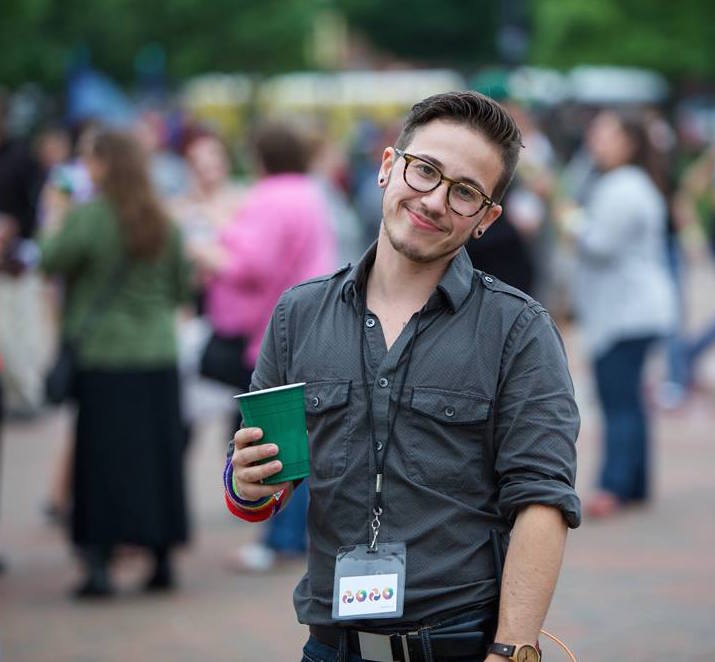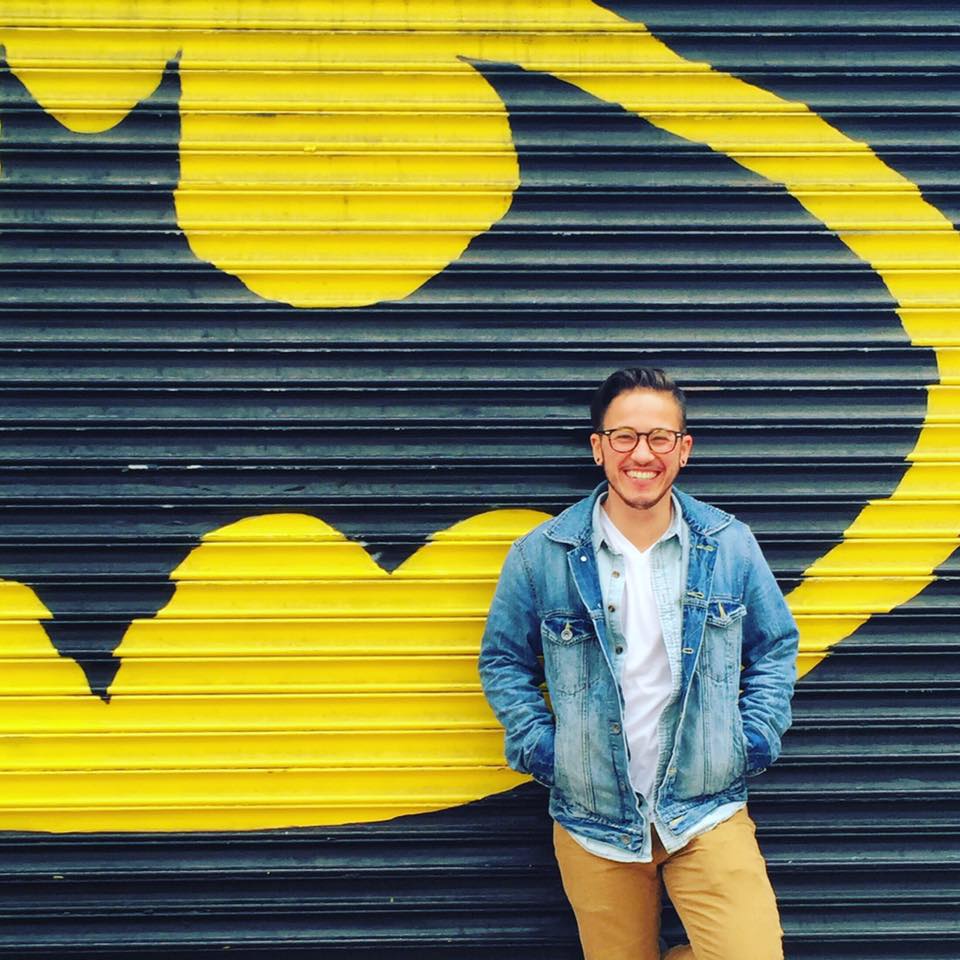Having embraced who he really is, this transgender man uses his voice to advocate for others.
This is part of a story series about the lives of transgender people. Read the introduction here.
 Until he came out as transgender at age 25, Jay Maddock felt trapped. He felt like a fraud for not presenting his authentic self to the world — or, for many of those years, even to himself.
Until he came out as transgender at age 25, Jay Maddock felt trapped. He felt like a fraud for not presenting his authentic self to the world — or, for many of those years, even to himself.
It’s not that his childhood or adolescence were terrible. A lot of times were really good, growing up in a loving family. But Maddock would have what he calls “lost boy memories”: brief moments when his authentic self was trying to shine through.
The first was when I was 5 years old. I was walking on the beach with my dad and I told him I wanted to be a boy. He asked why, and I said I wanted to play basketball and I wanted to have a wife.
My dad said that I could be a girl and play basketball and have a wife, which solved that 5-year-old conflict.
Although the feelings of conflict would return, Maddock says his parents were always supportive, letting him dress how he wanted and play with the toys he liked. “When the girls would play house at recess, I’d be playing basketball or football with the boys,” he says.
There’s another moment that’s vivid in his memory, when his grandmother took Maddock and his younger brother shopping for school clothes. His grandmother was adamant that Maddock should wear skirts and dresses, but he insisted on baggy pants.
“There was a World War III in J.C. Penney,” he recalls, “with us screaming back and forth. My dad finally stepped in to find a compromise.”
Maddock says two photos taken when he was about 10 years old capture memories like those for eternity.
In one, I’m wearing a skirt and staring at my brother, who is wearing jeans. I’m clearly uncomfortable in my outfit. The next photo is of me wearing plaid slacks, suspenders and a pleather jacket. I’m in front of my brother, pushing him out of the way because I’m so proud to show off the outfit I picked out. I’m just beaming.
Things got more challenging once Maddock entered middle school, because he got teased for not wanting to wear feminine clothes like girls his age did. He says he knew he was different, but didn’t know exactly what it meant, a feeling that continued into high school.
“I wasn’t comfortable in my body,” he says. “I wore baggier and baggier clothes to hide my body. I didn’t see anyone like me. The closest I could see were Ellen DeGeneres and Rosie O’Donnell, who were more masculine and gay. So I thought that must be me.”
At age 15, Maddock came out as gay, although he never referred to himself as a lesbian, feeling that identity was too “girly” to describe him accurately. Although he was the only student who was openly gay at his school, Maddock says his experience wasn’t too bad.
Yet he struggled with depression throughout his adolescence. He still didn’t feel comfortable in his own body. Even as he began to consider the idea that he might be transgender, he never told his therapist. “I wasn’t honest with my therapist because I wasn’t being honest with myself,” he says.
For the next few years, Maddock lived in what he describes as a “gray area,” which drove him deeper into depression. In college, he realized he was transgender, and had asked people to start calling him “Jay” — a long-time nickname even before he transitioned — but the thought of coming out again felt too exhausting. So he lived in that androgynous gray area where he responded to whatever gender pronouns people assigned to him, instead of choosing for himself.
But the day came when that was no longer good enough, he says.
I was becoming more and more depressed, so I was either going to come out as transgender or not be able to exist in the world anymore.
It was the New Year and I realized I didn’t want to waste another year. I had this huge panic attack, realizing what I was feeling was not going away and I was going to deal with it one way or another. I’d either take a deep breath and come out and take the risk of losing people, or I would risk losing myself.
Maddock came out first to his best friend, with a text characteristic of their friendship. The text said, “Dude, I’m a guy.” His friend’s response? “Duh. Yay!”
Armed with the reassuring normalcy of that exchange, Maddock then told his family. It took most of them a little time to become comfortable with the news, but they remained the supportive, loving family Maddock had always known. Ultimately, he says, it’s because his family recognized that he was the same person they’d always known.
On a family cruise, when they were trapped on a boat with me, they got to see that I was the same person, with the same values they raised me with. They also got to see that I was lighter, I wasn’t carrying as much with me. That removed their fears and hesitations.
That’s one of the greatest things I’ve learned through my transition, is that people’s fears come out in a variety of ways, and can sometimes blur the lines of love. It takes some time for people to dismantle their fears and reconnect with the humanity of the person they love and know.
Maddock says the process of coming out as transgender was much more difficult than coming out as gay, because coming out as transgender was more real. “I was more vulnerable because it was more personal,” he says. “It was scarier because I knew this was really who I was when I came out as transgender.”
Now 30 years old, Maddock is executive director at the Kalamazoo Gay Lesbian Resource Center. He’s been taking hormones for four years and had top surgery three years ago. Especially given the work he does, he knows that not every transgender person needs surgery or hormones. But he says those steps have made him feel more complete.
The act of transitioning started the process of falling in love with myself. If you can imagine the start of a relationship with someone you’re head over heels in love with — that giddiness every time you get to see them. There’s something similar about transitioning and starting to see yourself externally the way you’ve always known yourself internally, of finally getting to meet the person you’ve always had inside.
I’m happier and healthier now. I go to the gym and exercise — things I never did before, because they made me face a body I was at war with. I enjoy meeting people and exploring the world and getting to live, because it’s like a rebirth, along with the feeling of excitement and giddiness that comes with getting to wake up and be me every day.
As someone who advocates for other transgender people, Maddock acknowledges his privilege. Like many transgender men, he is less likely to be questioned about his gender than transgender women often are. What’s more, he says, by transitioning to male he gained the privilege that men enjoy in our society.
“Trans men often have faster access to ‘passing privilege’ than trans women based on stereotypical roles of men and women in this country,” he says. “I also have access to white privilege and I have the privilege of having had enough money to start my transition as soon as I was ready.”
 Maddock points out that most anti-transgender rhetoric focuses on trans women, based largely on the outright lie that transgender women are nothing more than men in dresses who are up to no good. He knows these fear-mongering myths — the same ones that lead to discriminatory “bathroom bills” — are born out of the lack of familiarity most people have with anyone who is transgender.
Maddock points out that most anti-transgender rhetoric focuses on trans women, based largely on the outright lie that transgender women are nothing more than men in dresses who are up to no good. He knows these fear-mongering myths — the same ones that lead to discriminatory “bathroom bills” — are born out of the lack of familiarity most people have with anyone who is transgender.
“About 3% of the population says they know a trans person,” he says. “When you don’t know any real transgender people, it’s very easy to dehumanize them because you already don’t see them as a person. So that fear, combined with the fact that we haven’t addressed sexism and racism in this country, makes it very easy to turn trans women into ‘the bad guy’ when in fact that is not the case.”
Recognizing his privilege — which includes what he calls “the Harry Potter invisibility cloak” that allows him to walk through public spaces and consistently be called “sir” — Maddock is using it to help those who may not be in a position to lift up their own voices.
He admits he’s gotten death threats and has been harassed, but in the scheme of things, Maddock knows he’s in a safer position to speak out than many other transgender people are. So he’s telling others what every transgender person wishes everyone knew.
“Transgender people are all different, just like everyone else,” he says. “Transgender or not, all any of us wants in this world is to be respected and have our humanity recognized. All we want is to be able to live our lives, and we deserve respect and dignity.”
Read all the stories in this series HERE.
[Photos courtesy of Jay Maddock.]



